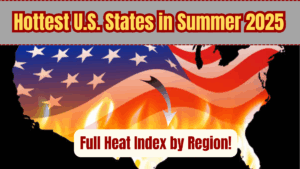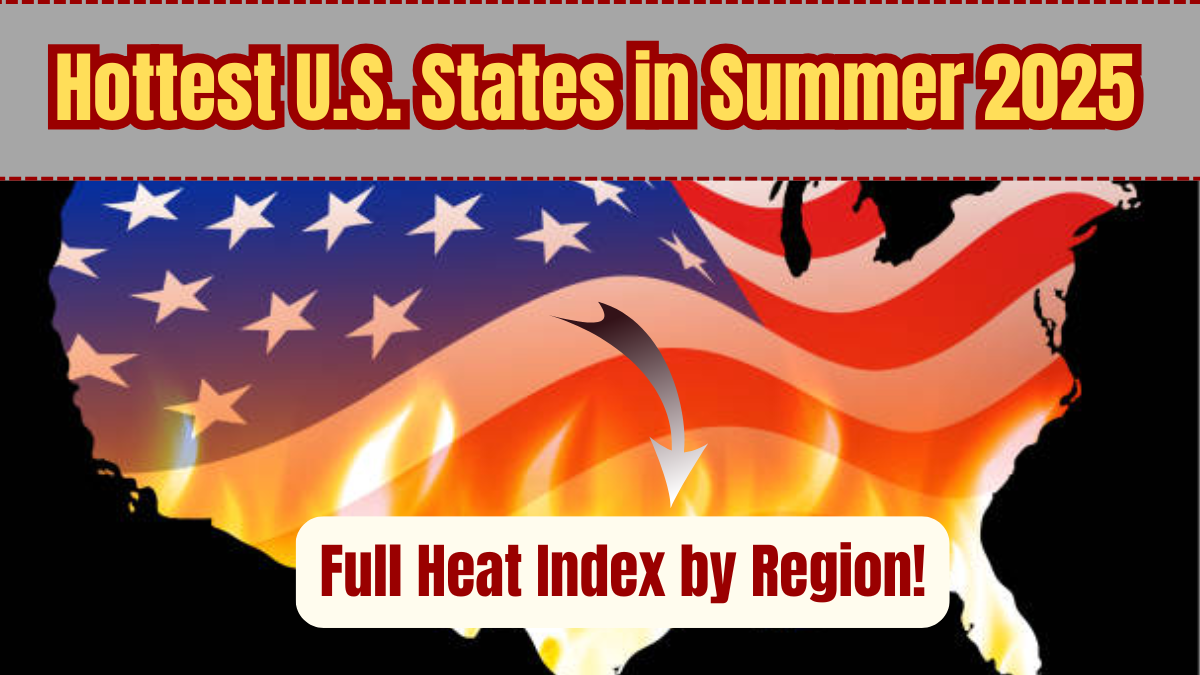The hottest states USA summer 2025 are setting records across the South, Southwest, and even parts of the Midwest as the nation enters one of the most extreme summers in recent memory. The July 2025 weather forecast from NOAA and regional climate centers reveals sweltering temperatures, prolonged heatwaves, and elevated heat index warnings across multiple states.
If you’re wondering which states are bearing the brunt of this intense summer, our heatwave states ranking and summer temperature map offer a comprehensive breakdown.

Heatwave Trends in the U.S. – Summer 2025 Overview
As of May and July 2025 climate tracking, the U.S. has already seen temperature spikes 10–15°F above average in several key regions. The main drivers include:
-
El Niño patterns boosting inland temperatures
-
Drier-than-usual conditions in western and southern states
-
Urban heat island effects increasing night-time temps
Meteorologists warn that heat-related illnesses and power outages may rise sharply if the pattern continues through August.
Top 10 Hottest States in the USA – Summer 2025 Ranking
Based on NOAA and AccuWeather data, these are the hottest states USA summer 2025 ranked by average daily high temperatures (June–July 2025):
| Rank | State | Avg. Daily High (°F) | Notable Cities Affected |
|---|---|---|---|
| 1 | Arizona | 108.3°F | Phoenix, Yuma |
| 2 | Nevada | 106.1°F | Las Vegas, Henderson |
| 3 | Texas | 104.7°F | Dallas, Austin, El Paso |
| 4 | California | 103.2°F | Palm Springs, Bakersfield |
| 5 | New Mexico | 101.9°F | Albuquerque, Roswell |
| 6 | Oklahoma | 100.6°F | Tulsa, Oklahoma City |
| 7 | Florida | 99.4°F (High Humidity) | Miami, Orlando |
| 8 | Louisiana | 98.9°F | Baton Rouge, New Orleans |
| 9 | Mississippi | 97.5°F | Jackson, Gulfport |
| 10 | Georgia | 97.0°F | Atlanta, Savannah |
Arizona and Nevada top the list once again, while states like Texas and Florida continue to see dangerous heat indexes due to humidity.
July 2025 Weather Forecast Highlights
According to the July 2025 weather forecast, the southern half of the country will experience multiple high-pressure heat domes, leading to:
-
Heat advisories across 24 states by mid-July
-
Nighttime lows staying above 85°F in major cities
-
Drought expansion in West Texas and New Mexico
-
Increased wildfire risk in California and Nevada
The Northeast and Pacific Northwest are expected to have more moderate temperatures, but short bursts of heat are likely between July 10–25.
Heat Index vs. Actual Temperature
The heat index reflects what the temperature feels like when humidity is factored in. In Florida and Louisiana, heat index values have reached 120°F, even when the actual temperature is under 100°F. This increases the risk of dehydration, heatstroke, and power demand surges.
Safety Measures During Extreme Heat
Health officials and emergency response agencies urge residents in the hottest states USA summer 2025 to follow these precautions:
-
Stay indoors during peak sun (10 AM to 4 PM)
-
Use cooling centers if available
-
Stay hydrated (avoid caffeine and alcohol)
-
Limit outdoor exercise and wear loose clothing
-
Keep elderly and pets safe from overheating
FAQs
Which are the hottest states in the USA during summer 2025?
As of July 2025, the top five hottest states are Arizona, Nevada, Texas, California, and New Mexico based on average daily high temperatures.
What causes these states to be so hot in summer?
Factors include arid geography, high-pressure systems, El Niño influences, and minimal precipitation which amplify heat and prevent cooling.
What is the July 2025 weather forecast for the U.S.?
The forecast predicts above-average temperatures across the South and Southwest, with ongoing heatwaves, high humidity in coastal regions, and expanding drought in inland areas.
How is the heat index different from the actual temperature?
The heat index combines temperature and humidity to reflect the “feels-like” temperature. For example, 95°F with high humidity may feel like 115°F.
What can I do to stay safe during extreme heat?
Limit sun exposure, stay in air-conditioned spaces, drink water regularly, and check on vulnerable populations like children and the elderly.
Click here to know more.
